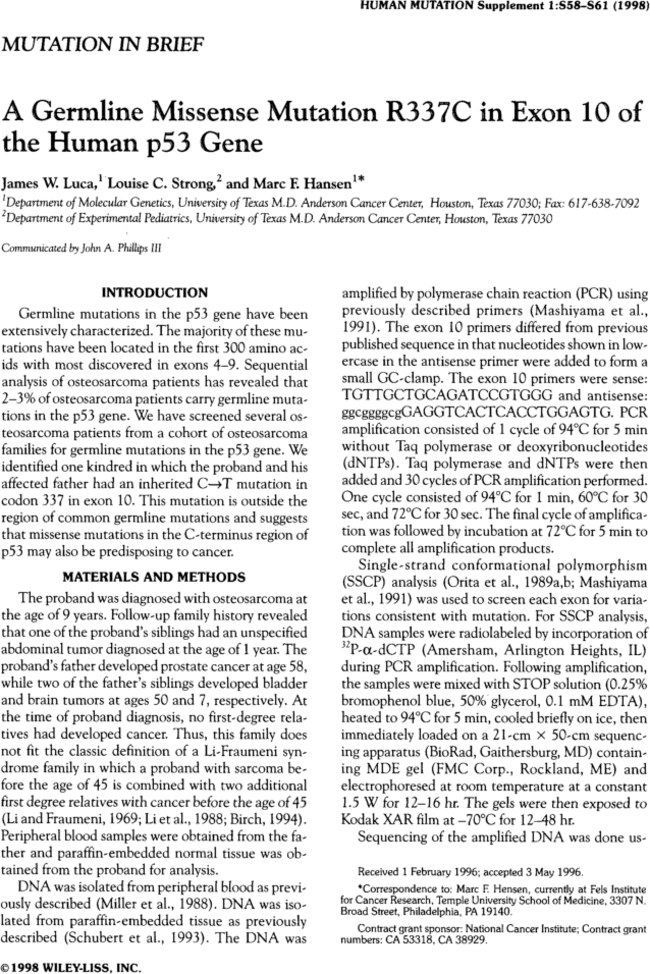A germline missense mutation R337C in exon 10 of the human p53 gene
James W. Luca
Department of Molecular Genetics, University of Texas M.D. Anderson Cancer Center, Houston, Texas 77030; Fax: 617-638-7092
Search for more papers by this authorLouise C. Strong
Department of Experimental Pediatrics, University of Texas M.D. Anderson Cancer Center, Houston, Texas 77030
Search for more papers by this authorCorresponding Author
Marc F. Hansen
Department of Molecular Genetics, University of Texas M.D. Anderson Cancer Center, Houston, Texas 77030; Fax: 617-638-7092
Fels Institute for Cancer Research, Temple University School of Medicine, 3307 N. Broad Street, Philadelphia, PA 19140Search for more papers by this authorJames W. Luca
Department of Molecular Genetics, University of Texas M.D. Anderson Cancer Center, Houston, Texas 77030; Fax: 617-638-7092
Search for more papers by this authorLouise C. Strong
Department of Experimental Pediatrics, University of Texas M.D. Anderson Cancer Center, Houston, Texas 77030
Search for more papers by this authorCorresponding Author
Marc F. Hansen
Department of Molecular Genetics, University of Texas M.D. Anderson Cancer Center, Houston, Texas 77030; Fax: 617-638-7092
Fels Institute for Cancer Research, Temple University School of Medicine, 3307 N. Broad Street, Philadelphia, PA 19140Search for more papers by this author
References
- Beroud C, Verdier F, Soussi T (1996) p53 gene mutation: software and database. Nucleic Acids Res 24: 147–150.
- Birch JM (1994) Familial cancer syndromes and clusters. Br Med Bull 50: 624–639.
- Greenblatt MS, Bennett WP, Hollstein M, Harris CC (1994) Mutations in the p53 tumor suppressor gene: Clues to cancer etiology and molecular pathogenesis. Cancer Res 54: 4855–4878.
- Hollstein M, Shomer B, Greenblatt M, Soussi T, Hovig E, Montesano R, Harris CC (1996). Somatic point mutations in the p53 gene of human tumors and cell lines: Updated compilation. Nucleic Acids Res 24: 141–146.
- Li FP, Fraumeni JF (1969) Soft-tissue sarcomas, breast cancer, and other neoplasms: A familial syndrome? Ann Intern Med 71: 747–752.
- Li FP, Fraumeni JF, Mulvihill JJ, Blattner WA, Dreyfus MG, Tucker MA, Miller RW (1988) A cancer family syndrome in twenty-four kindreds. Cancer Res 48: 5358–5362.
- Mashiyama S, Murakami Y, Yoshimoto T, Sekiya T, Hayashi K (1991) Detection of p53 gene mutations in human brain tumors by single-strand conformation polymorphism analysis of polymerase chain reaction products. Oncogene 6: 1313–1318.
- Miller SA, Dykes DD, Polesky HF (1988) A simple salting out procedure for extracting DNA from human nucleated cells. Nucleic Acids Res 16: 1215.
- Orita M, Iwahana H, Kanazawa H, Hayashi K, Sekiya T (1989a) Detection of polymorphisms of human DNA by gel electrophoresis as single-strand conformation polymorphisms. Proc Natl Acad Sci USA 86: 2766–2770.
- Orita M, Suzuki Y, Sekiya T, Hayashi K (1989b) Rapid and sensitive detection of point mutations and DNA polymorphisms using the polymerase chain reaction. Genomics 5: 874–879.
- Plummer SJ, Santibanez-Koref M, Kurosaki T, Liao S, Noble B, Fain PR, Anton-Culver H, Casey G (1994) A germline 2.35 kb deletion of p53 genomic DNA creating a specific loss of the oligomerization domain inherited in a Li-Fraumeni syndrome family. Oncogene 9: 3273–3280.
- Prives C, Manfredi JJ (1993) The p53 tumor suppressor protein: Meeting review. Genes Dev 7: 529–534.
- Reed M, Wang Y, Mayr G, Anderson ME, Schwedes JF, Tegtmeyer P, (1993) p53 domains: Suppression, transformation, and transactivation. Gene Expr 3: 95–107.
- Schubert EL, Bischoff FZ, Whitaker LL, Pleasants LM, Hansen MF (1993) A method to isolate DNA from small archival tissue samples for p53 gene analysis. Hum Mutat 2: 123–126.
- Wang P, Reed M, Wang Y, Mayr G, Stenger JE, Anderson ME, Schwedes JF, Tegtmeyer P, (1994) p53 domains: Structure, oligomerization, and transformation. Mol Cell Biol 14: 5182–5191.




